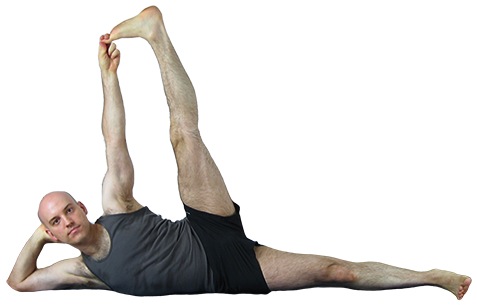Anantāsana on:
[Wikipedia]
[Google]
[Amazon]
 Anantasana ( sa, अनन्तासन;
Anantasana ( sa, अनन्तासन;
 The name comes from the Sanskrit words '' anantā'' (अनन्त) meaning "without end" or "the infinite one", for the thousand-headed serpent
The name comes from the Sanskrit words '' anantā'' (अनन्त) meaning "without end" or "the infinite one", for the thousand-headed serpent
Technique
{{DEFAULTSORT:Anantasana Reclining asanas Core strength asanas Asymmetric asanas
 Anantasana ( sa, अनन्तासन;
Anantasana ( sa, अनन्तासन; IAST
The International Alphabet of Sanskrit Transliteration (IAST) is a transliteration scheme that allows the lossless romanisation of Indic scripts as employed by Sanskrit and related Indic languages. It is based on a scheme that emerged during ...
: ''Anantāsana''), Sleeping Vishnu Pose or Vishnu's Couch Pose, Eternal One's Pose, or Side-Reclining Leg Lift is an asana
An asana is a body posture, originally and still a general term for a sitting meditation pose,Verse 46, chapter II, "Patanjali Yoga sutras" by Swami Prabhavananda, published by the Sri Ramakrishna Math p. 111 and later extended in hatha yoga ...
in modern yoga as exercise
Yoga as exercise is a physical activity consisting mainly of postures, often connected by flowing sequences, sometimes accompanied by breathing exercises, and frequently ending with relaxation lying down or meditation. Yoga in this form has ...
.
Etymology and origins
 The name comes from the Sanskrit words '' anantā'' (अनन्त) meaning "without end" or "the infinite one", for the thousand-headed serpent
The name comes from the Sanskrit words '' anantā'' (अनन्त) meaning "without end" or "the infinite one", for the thousand-headed serpent Shesha
Shesha ( Sanskrit: शेष; ) , also known as Sheshanaga ( Sanskrit: शेषनाग; ) or Adishesha (), is a serpentine demigod (Naga) and Nagaraja (King of all serpents), as well as a primordial being of creation in Hinduism. In the ...
upon which Vishnu
Vishnu ( ; , ), also known as Narayana and Hari, is one of the principal deities of Hinduism. He is the supreme being within Vaishnavism, one of the major traditions within contemporary Hinduism.
Vishnu is known as "The Preserver" withi ...
rested at the bottom of the primordial ocean, and āsana (आसन) meaning "posture" or "seat".
A different reclining pose named Anantasana is described and illustrated in the 19th century ''Sritattvanidhi
The ''Sritattvanidhi'' (, "The Illustrious Treasure of Realities") is a treatise written in the 19th century in Karnataka on the iconography and iconometry of divine figures in South India. One of its sections includes instructions for, and ill ...
''. The modern pose is described in the 1966 ''Light on Yoga
''Light on Yoga: Yoga Dipika'' (Sanskrit: योग दीपिका, "Yoga Dīpikā") is a 1966 book on the Iyengar Yoga style of modern yoga as exercise by B. K. S. Iyengar, first published in English. It describes more than 200 yoga posture ...
''.
Description
Anantasana is entered from a lying position. The head is supported with one hand, the upper arm on the ground on that side; the other hand and leg are stretched straight up, the fingers grasping the big toe of the raised foot. The supporting arm, body, and lower leg are in a straight line.See also
* List of asanasReferences
Further reading
*External links
Technique
{{DEFAULTSORT:Anantasana Reclining asanas Core strength asanas Asymmetric asanas